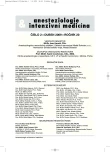Erythropoietin and other erythropoiesis-stimulating drugs and bloodless medicine – a new era in the management of anaemia?
Authors:
Stibor Bronislav; Schwameis Franz
Authors‘ workplace:
Abteilung für Anästhesie und Intensivmedizin, Landesklinikum Baden, Baden bei Wien, Rakousko
Published in:
Anest. intenziv. Med., 20, 2009, č. 2, s. 84-87
Category:
Anaesthesiology - Review Article
Overview
Bloodless medicine tries to find and put into practice alternatives to allogeneic transfusions. The biggest risk when receiving a blood transfusion is the transmission of infectious diseases. Since the 1980s the recombinant human erythropoietin has been used in anaemia treatment, the first of the group of erythropoiesis stimulating agents. Its main disadvantage is the need for frequent applications; a very serious complication – pure red-cell aplasia - occurs rarely.
A second generation drug – darbepoetin – features a modified chemical structure and more favourable pharmacokinetics. A third generation representative of continuous erythropoietin receptor activators will soon be introduced into clinical practice featuring a many times longer biological half-time. The forth generation represents a qualitative leap with oral preparations made up without the help of genetic engineering, starting a new era in anaemia management. However, only the introduction of artificial blood into clinical practice will make blood transfusion a rare procedure.
Keywords:
bloodless medicine – erythropoiesis stimulating agents – erythropoietin – darbepoetin – pure red-cell aplasia – continuous erythropoietin receptor activator – Hematide
Sources
1. Kitchen, A. D., Barbara, J. A. Current information on the infectious risks of allogeneic blood transfusion. Transfusion Alternatives in Transfusion Medicine, 2008, 10, 3, p. 102–111.
2. Cundrle, I., Vlach, O., Zimova, I., Pospisilova, M. Initial experience with peroperative autotransfusion in spinal surgery. Acta Chir. Orthop. Traumatol. Cech., 1993, 60, 2, p. 93–97.
3. Gal, R., Cundrle, I. Acute normovolemic haemodilution for management 4 200 ml large blood loss during radical prostatectomy. Bratisl. Lek. Listy, 2002, 103, 6, p. 198–200.
4. Gal, R. Acute normovolemic haemodilution for management of blood loss during radical prostatectomy. Bratisl. Lek. Listy, 2008, 109, 3, p. 144–146.
5. Segal, J. B., Blasco-Colmenares, E., Norris, E. J., Guallar, E. Preoperative acute normovolemic hemodilution: a meta analysis. Transfusion, 2004, 44, p. 632–644.
6. Tesař, V., Tesařová, P. Darbepoetin alfa. Farmakoterapie, 2006, 5, p. 514–522.
7. Kampf, D., Kahl, A., Passlick, J., Pustelnik, A. et al. Single dose kinetics of recombinant human EPO (rhEPO) after i.v., s.c. and i.p. administration. Control. Nephrol., 1989, 76, p. 106–111.
8. Cournoyer, D., Toffelmire, E. B., Wells, G. A., Baeber, D. L. et al. Anti-Erythropoietin Antibody-Mediated Pure Cell Aplasia after Treatment with Recombinant Erythropoietin Products: Recommendations for Minimization of Risk. J. Am. Soc. Nephrol., 2004, 15, p. 2728–2734.
9. McKoy, J. M., Stonecash, R. E., Cournoyer, D., Rossert, J., Nissenson, A. R., Raisch, D. W. et al. Epoetin-associated pure red cell aplasia: past, present, and future consideration. Transfusion, 2008, 48, 8, p. 1752–1762.
10. Bennett, C. L., Luminari, S., Nissenson, A., Tallman, M. S. et al. Pure Red-Cell Aplasia and Epoetin Therapy. N. Engl. J. Med., 2004, 351, p. 1403–1408.
11. Schellekens, H., Jiskoot, W. Erythropoietin-Associated PRCA: Still an Unsolved Mystery. J. Immunot., 2006, 3, p. 123–130.
12. Chang, W. J., Tan, L. K., Liu, T. C. Cyclosporine treatment for patients with CRF who developed pure red blood cell aplasia following EPO therapy. Am. J. Kidney Dis., 2003, 41, p. 692–695.
13. Dostupné na: Amgen Inc. Product Information. http://www.aranesp.com
14. Macdougall, I. C., Gray, S. J., Elston, O., Breen, C. et al. Pharmacokinetics of novel erythropoiesis stimulating protein compared with epoetin alfa in dialysis patients. J. Am. Soc. Nephrol., 1999, 10, p. 2392–2395.
15. Summers, S. A., Matijevic, A., Almond, M. K. Successful re-introduction of recombinant human erythropoietin following antibody induced pure cell aplasia. Nephrol. Dial. Transplant., 2004, 19, p. 2137–2139.
16. Macdougall, I. C. CERA (continuous erythropoietin receptor activator): a new erythropoiesis-stimulating agent for treatment of anemia. Curr. Hematol. rep., 2005, 4, p. 436–440.
17. Macdougall, I. C. Novel Erythropoiesis-Stimulating Agents: A New Era in Anemia Management. J. Am. Soc. Nephrol., 2008, 3, p. 200–207.
18. Stead, R. B., Lamber, J., Wessels, D., Iwashita, J. et al. Evaluation of the safety and pharmacodynamics of Hematide, a novel erythropoietic agent, in a phase1, double-blind, placebo-controlled, dose-escalation study in healthy volunteers. Blood, 2006, 108, p. 1830–1834.
Labels
Anaesthesiology, Resuscitation and Inten Intensive Care MedicineArticle was published in
Anaesthesiology and Intensive Care Medicine

2009 Issue 2
Most read in this issue
- Anaphylaxis after induction to general anaesthesia: Four case reports
- Erythropoietin and other erythropoiesis-stimulating drugs and bloodless medicine – a new era in the management of anaemia?
- Anterior spinal artery syndrome as a complication of neuroaxial blocade – successful treatment with prostacyclin (case report)
- A fatal complication of tracheostomy in a 13-year-old patient with Duchenne Muscular Dystrophy – case report
